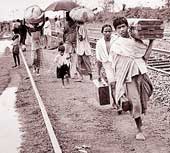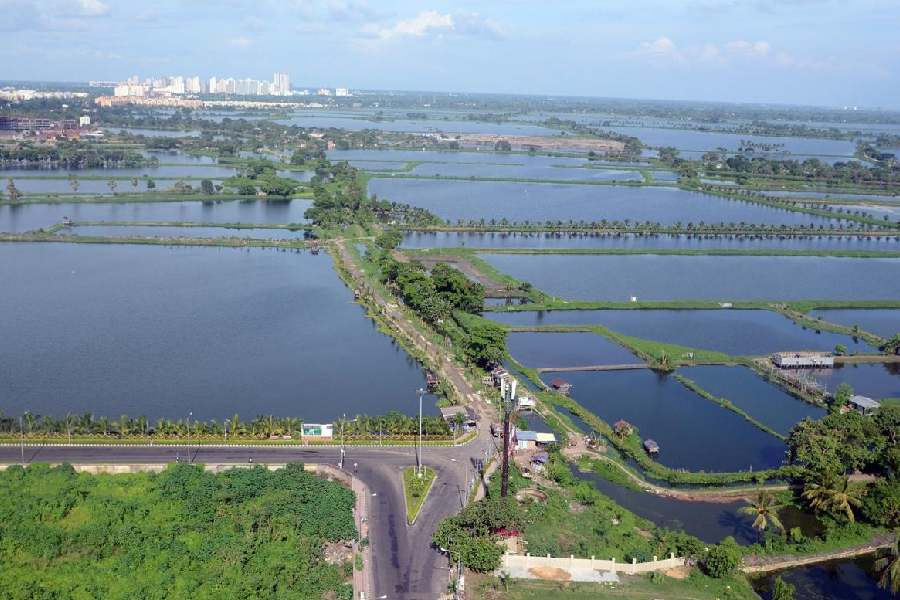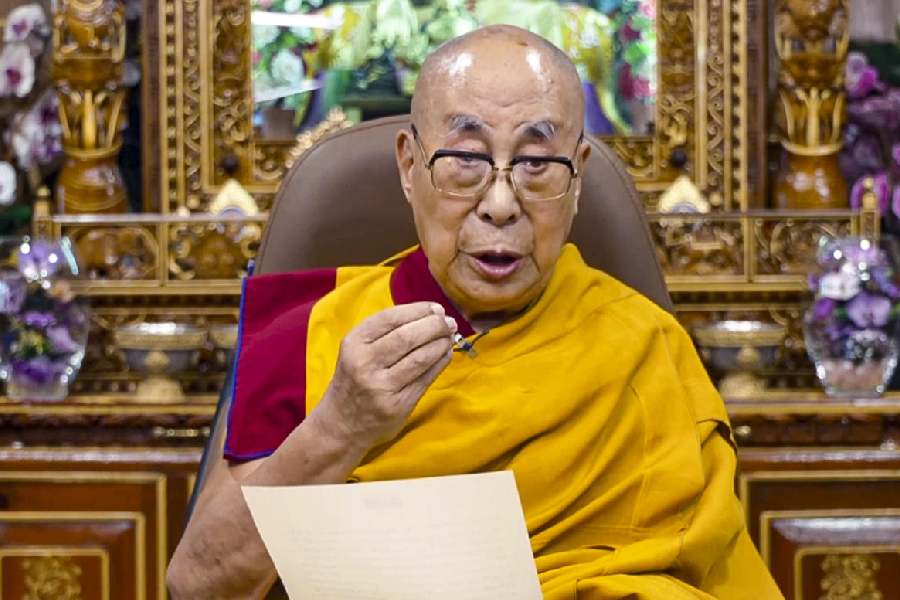|
|
Small is no longer considered beautiful. Innocent of the art of public relations, the humble species remain outside the pale of self-advertising. And in the globalized milieu, the puny ones, it has been suggested, have not even the right to exist.
If this injunction were followed to the hilt, it is bound to sound the death-knell of human civilization, which is, come to think of it, the sum total of discrete creativities in different spheres. More often than not, these acts of creation take place, on a modest scale, in nondescript arenas, among individuals without social or class credentials. This morning?s column is intended to offer unabashed homage to one such seemingly modest contribution ? in the field of biographical literature.
A slim paperback, published on the occasion of the annual event of the Calcutta Book Fair, consisting of barely eighty small-size pages, easily slipping into a woman?s handbag or a man?s kurta pocket. The book is blandly titled Shei Shab Din (?Those Days?). It has five short chapters, written in elegant, but sparkling, Bengali. The sentences are crisp, splendoured by a light cadence, and yet not lacking in syntactical rigour. The author, Ila Gupta, is a housewife and a retired schoolteacher. The book packs her reminiscences from her childhood till her withdrawal into retirement in the sleepy, dusty town of Suri in southern Bengal: the annals of an ordinary life ordinarily lived. It however refers to episodes with cataclysmic consequences for the nation. Ila Gupta?s synoptic portrayal of those events attains a grandeur hardly equalled by ponderous tomes running into five hundred or a thousand pages.
It is little use nurturing illusions. The book?s publisher does not belong to the big league and it is unlikely to attract many reviews. Few copies will therefore be sold. Should that happen, it would not be the author?s loss though. It is not exactly a coincidence that the quality of her writing is matched by the sensitivity of her mind. That apart, Shei Shab Din, in a manner of speaking, encapsulates the pride and predicament the Bengali middle class experienced across the span of the 20th century. Ila Gupta had not chosen her themes with any particular awareness that she was producing a saga about the fading bourgeoisie she once belonged to. But there it is. The first chapter is a recollection of her infant days spent in and around Sunamganj, a small river port in the Surma valley in the district of Sylhet, then in Assam, now in Bangladesh: snippets of narration of a short river trip on a passenger boat, the meandering river, the human settlements on either shore. She crosses over to provide details of her big joint family, not forgetting to mention her Punjabi ancestry on the father?s side. She has vivid memories of the modest ancestral house in their native village next to Sunamganj. She describes the nor?westers, the floods, the fury of the river gobbling up village homesteads.
The next chapter is the author?s quiet tribute to the memory of her long-suffering mother, Charulata. The lady?s husband, an assistant manager in a tea estate in the lower terais, died early, leaving the widow to fend for herself and her half-a-dozen children. Back in Sunamganj, daily existence was a cumulation of unending challenges. More woes befell the family once the country was partitioned in 1947. The third chapter, ?Exodus?, recounts that story, and is both excruciatingly beautiful and excruciatingly heart-rending: harum-scarum departure, leaving behind whatever meagre earthly possessions they had, from the East Pakistan town to the ruthless anonymity of metropolitan Calcutta, a migration from being to nothingness. There is no expression of either rancour or self-pity in the telling of the tragic story. Ila Gupta mentions, with controlled emotion, the aching in the heart as she and her siblings said goodbye to their playmates and kindly neighbours in Sunamganj. The feeling of loss, she is scrupulous to add, was mutual: her teenage friends, belonging to another religious denomination, equally shared the pangs of severance.
?Exodus? chronicles the nightmarish travel by boat and train across the border, the wilderness of the southern suburbs of Calcutta where the family took shelter under a naked, hostile sky, the cynical absentmindedness of state authorities of the country they migrated to. Each of the experiences is sculpted with an amazing economy of words. What follows is a narration of the inspiring story of the magnificent collective endeavour of the refugees to build, on their own, new settlements by taking possession of fallow lands and putting into shape, with bare hands, colony after colony, shops, roads, markets, schools. Ila Gupta and her family were an integral part of that great story of reassertion of life on the part of the uprooted millions from East Pakistan.
A sudden kink in the script. A lady of their acquaintance selects Ila as bride for her nephew. After marriage, Ila Gupta finds herself in the midst of an amazing household settled in Suri. Her husband?s family too was from East Bengal, moderately affluent, with a distinguished Brahmo background and a record of selfless social service in Chittagong. But there was more to it. The younger generation was actively involved in the armed uprising planned by Surya Sen that led to the raid on the armoury and the European Club in April 1930. Of the three brothers in the family, the eldest was killed in the Jalalabad encounters; the middle one, Ananda, was, upon capture, transported for life to the Andamans. On his return, he was interned in Suri; where the rest of the family came over after Partition. Ila got married to the third brother.
Sort of a flashback here. The grandfather of Ila?s husband, Rajeshwar Gupta, was the first graduate in his village in the district of Dacca. He was the first Brahmo in the village too. His wife, Dravamayee, despite being unlettered, was a woman of tremendous personality and unusual moral courage. Social boycott of the family because of their Brahmo beliefs could not cramp her style; she wrested back for the family the dignity that was sought to be denied. After a while, the Guptas shifted to Chittagong, where Rajeshwar emerged as a leading citizen and an incorrigible do-gooder. It was Dravamayee however who ruled the roost in the family ? and in the neighbourhood. Her reputation as a harridan did not faze her. She was a women?s libber a century ahead of today?s Jennys-cum-lately. C.R. Das was a not-so-distant nephew who, on one visit to Chittagong, failed to call on the aunt. The aunt was not amused; she walked into the venue where Das was addressing a public meeting. C.R. Das was at the receiving end of a tongue-lashing. ?So Chitta, you have become such a grand leader that you can ignore your aunt. But say, fella, have you given up drinking??
The Chittagong armoury raid episode changed the parameters of existence. Dravamayee?s son, the father of the two rebels, had a nervous breakdown, the neighbours were scared of maintaining communications for fear of official wrath, but it was not all gloom. Dravamayee?s second daughter had married a Brahmo widower from Cuttack. She bore three sons; the middle one, Bijayananda Patnaik, better known as Biju, would often visit Chittagong and inquire after the grandmother and the cousins.
Ila Gupta?s final chapter conveys a tranquil autumnal mood: the season?s chores are done and it is time for quiet harvest-gathering. Not quite. The chapter includes an account of the harrowing days of the early Seventies when the young flock took the pledge to usher in instant revolution and faced indescribable police torture. Her own son was a target of state terror. Ila Gupta ends her tale with a demure, unobtrusive query: is there much of a qualitative difference between the idealism which fired the British-hating sentinels of her husband?s generation and that of the generation her son belonged to?
To describe Shei Shab Din as a tour de force will not do, for it is no razzle dazzle. It is still a remarkable contribution, a rare compound of grace, integrity and courage.











